Core PCE price index jumps MoM by most in 13 months on Non-Housing Services. Recreational Services blow out. Durable Goods continue 6-month trip out of deflation.
By Wolf Richter for WOLF STREET.
The inflation measure released today – the PCE price index favored by the Fed as yardstick for its inflation target – dished up another surprise.
While gasoline prices fell in February from January, and food prices were stable month-to-month after substantial increases in prior months, prices in core services jumped, driven by non-housing services, especially by the ongoing six-month-long red-hot spike in recreational services – the services that consumers want to buy.
Prices of durable goods stopped falling last year, and then started rising, initially driven by sharply rising used vehicle prices, after their historic plunge. I’ve been warning for months here that durable goods would no longer push down overall inflation readings.
These are retail prices of durable goods consumers purchased in February, well before any tariffs reached retail prices. It’s inflation pure and simple that has been creeping up for months, bouncing between various categories of non-housing services and some goods.
The core PCE price index, which excludes food and energy items, accelerated to +0.37% (+4.5% annualized) in February from January, the worst increase in 13 months, and January was revised higher, according to data from the Bureau of Economic Analysis today (blue in the chart below).
The 3-month core PCE price index accelerated to +3.6% annualized, the worst increase since March 2024.
The 6-month core PCE price index (red) accelerated to +3.1% annualized, the biggest increase since June 2024.
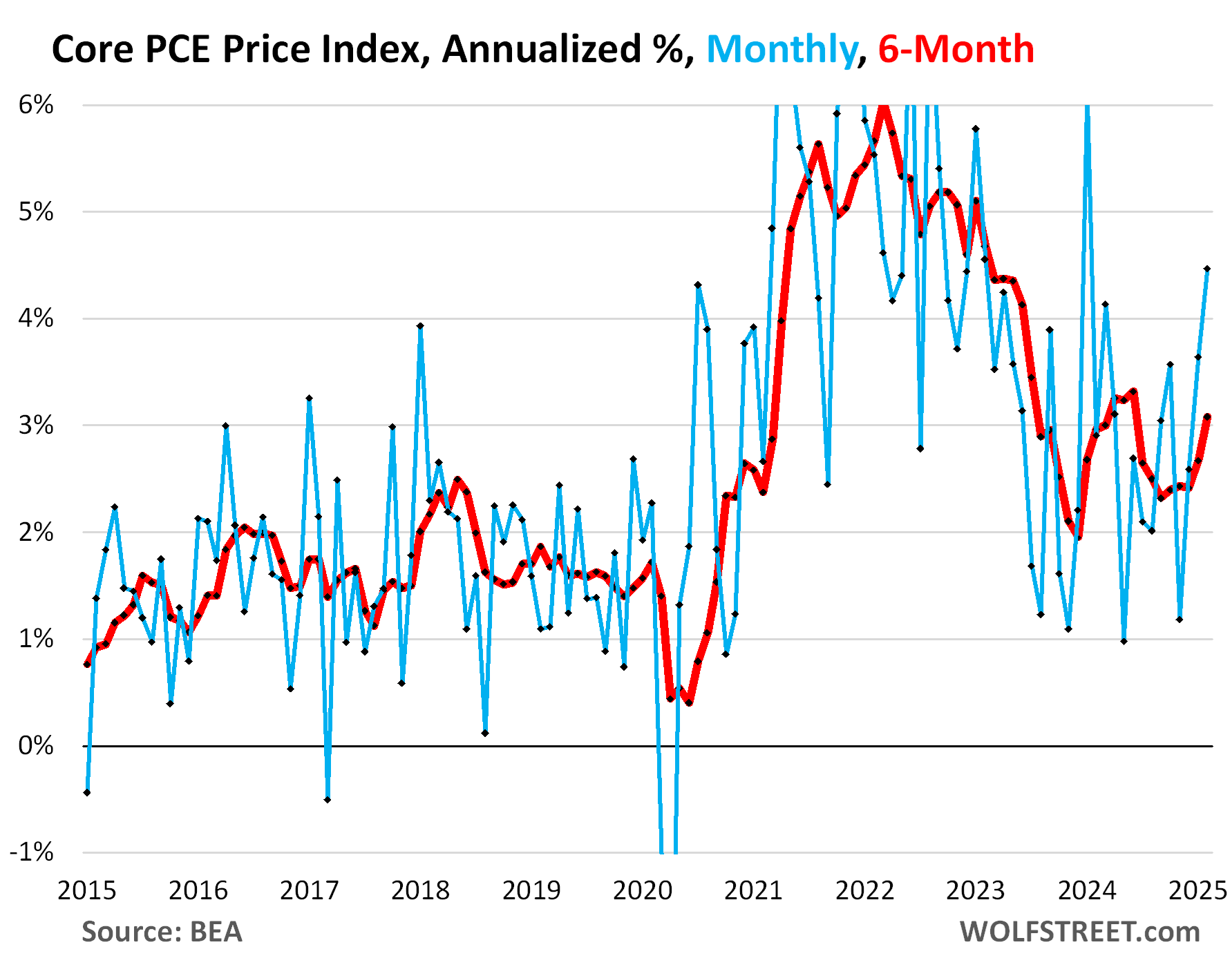
The overall PCE price index rose by 0.33% (+4.0% annualized), just a hair below the upwardly revised increase in January (originally reported as 4.0% and revised up today to 4.1%). Both were the worst month-to-month increases since March 2024
The 3-month PCE price index accelerated to +3.9% in February, the worst month-to-month increase since March 2024, and January was revised higher (to +3.0% from 2.9%).
The low point of the three-month index was in July (+1.1% annualized), and it has been accelerating ever since.
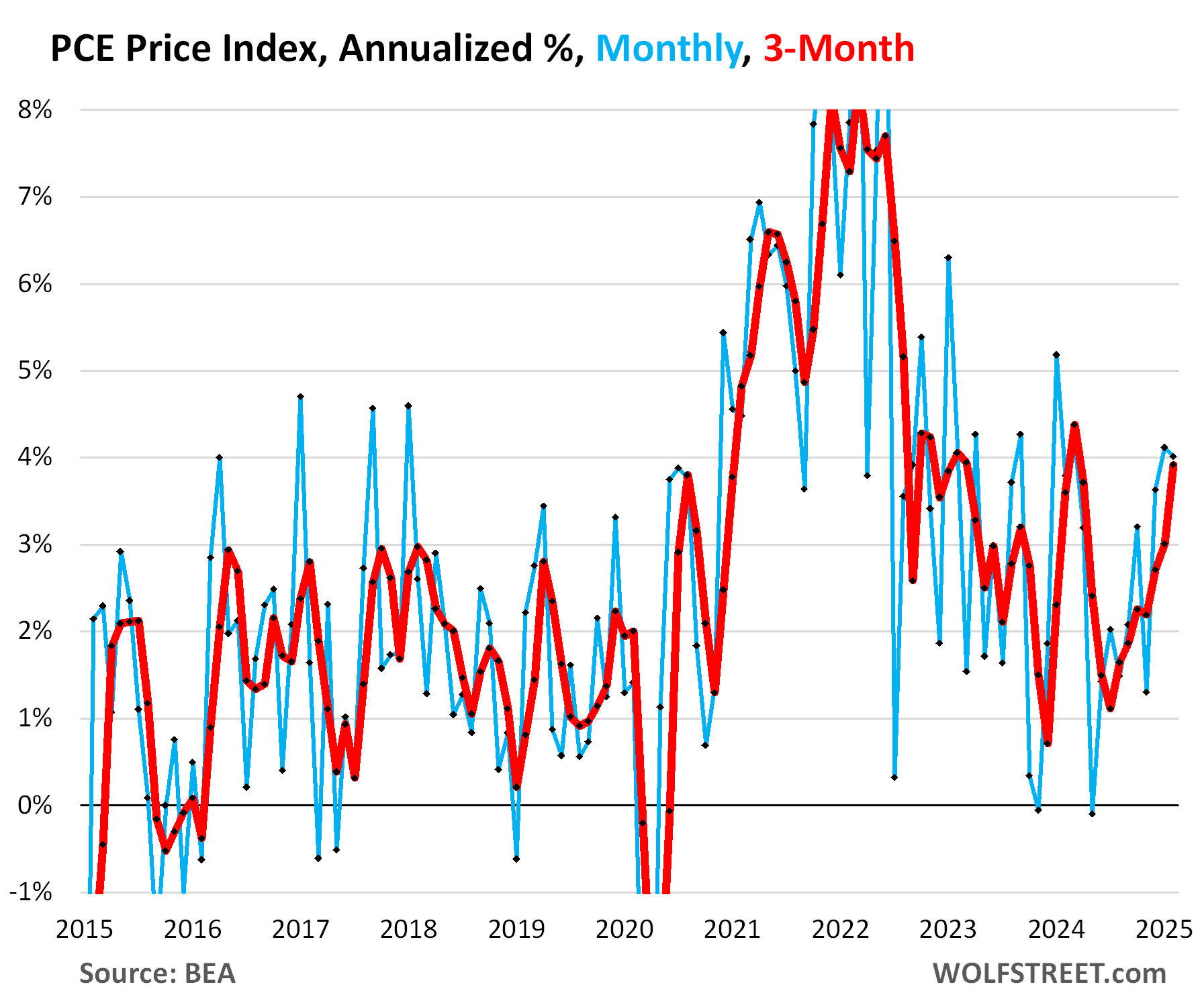
The 6-month PCE price index accelerated to +3.1%, the worst increase since September 2023.
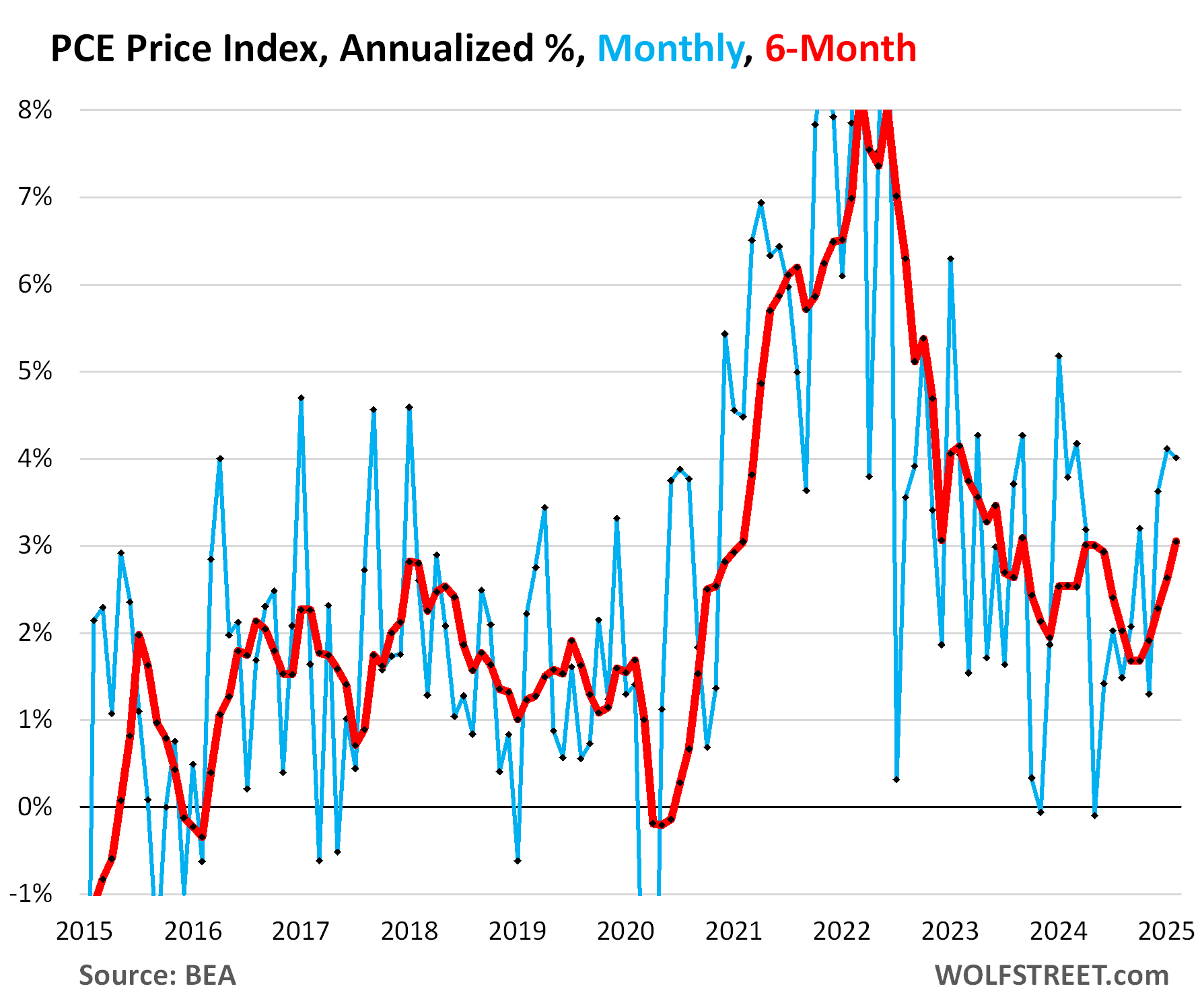
The core services PCE Price Index, which excludes energy services, accelerated in February to +0.35% (+3.6% annualized), driven by non-housing services, especially the ongoing red-hot surge in recreational services, and despite the deceleration in housing services (rent).
The 6-month core services PCE price index accelerated for the fifth month in a row to 3.7% annualized, the worst increase since June 2024. The low point was in September 2024.
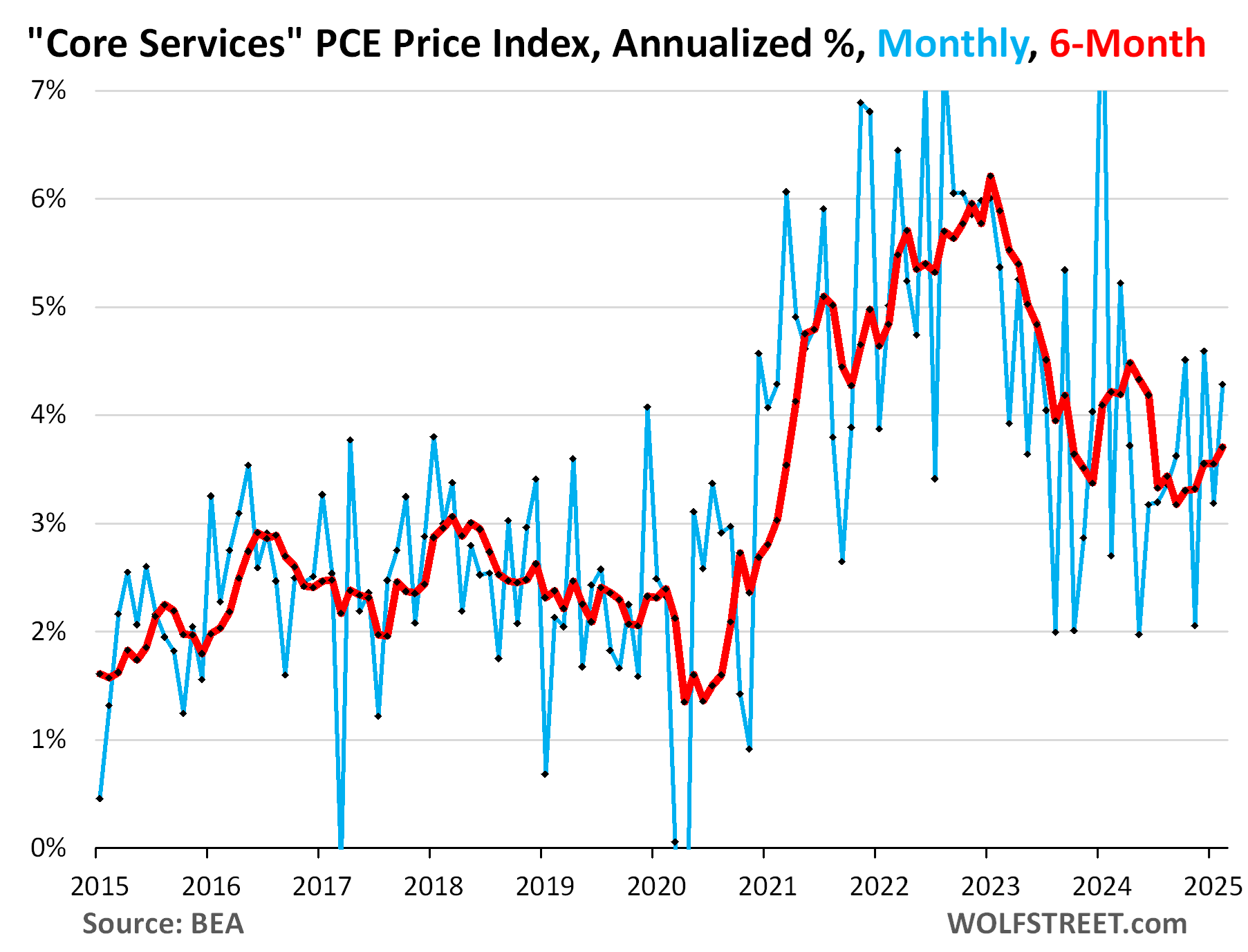
The Fed started rate cuts at the low point. Looking back, we can see that inflation was carving out a low point in the period of June through September 2024. With the August CPI data, I started pointing at this issue.
Used vehicle prices started rising, non-housing services started rising, food prices started accelerating again. By the October CPI, it became loud and clear: “Overall CPI Accelerates for 4th Month, “Core” CPI for 3rd Month on Re-spiking Used Vehicle Prices & Rising Homeowner Costs,” I said in the headline.
But in September, the Fed embarked on its rate cuts with a monster cut right after inflation had bottomed out and started to re-accelerate. The Fed was frazzled by the labor market data – which turned out to have been a false alarm – while it thought inflation had been licked, which it wasn’t.
Durable goods prices emerged from deflation. The six-month PCE Price index for durable goods started heading higher in September last year, when it was still in deflation (negative), and it became less negative, driven by positive month-to-month readings in September, October, January, and February. A big driver was used vehicles, whose prices have been resurging.

Housing inflation (rent) is no longer the culprit. The PCE price index for housing, which is part of core services, decelerated to +0.28% (+3.4% annualized).
The six-month index decelerated to 3.8% annualized, the lowest since September 2021. This measure of housing inflation is now back in the pre-pandemic range.
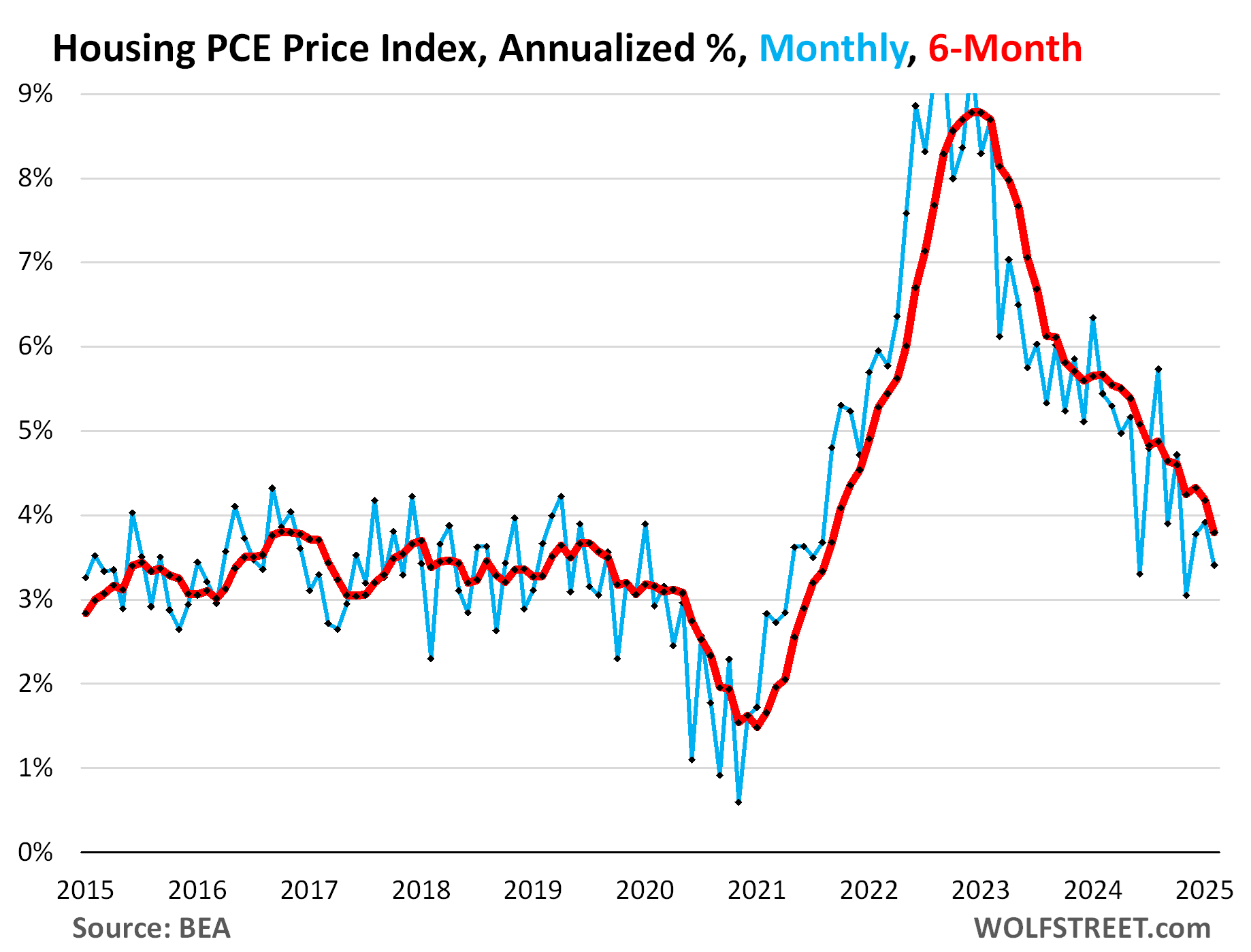
Inflation blows out in recreational services. This is a broad category of services that consumers want to buy, including: Cable and satellite services, broadband, amusement parks, campgrounds, concerts, spectator sports, movies, theaters, gambling, video streaming, vet services, package tours, memberships, clubs, participant sports centers and clubs, museums, maintenance and repair of recreational and sports equipment, etc.
The month-to-month increases began in, you guessed it, September 2024, and then in October became hot, and in January and February red-hot, off-the chart (literally), with 14.5% and 12.6% annualized month to month increases.
This pushed the six-month increase to +7.0%, the third-worst in this entire inflation cycle, behind only January and February 2023. The low point had been, you guessed it, in August 2024 at 1.0%.
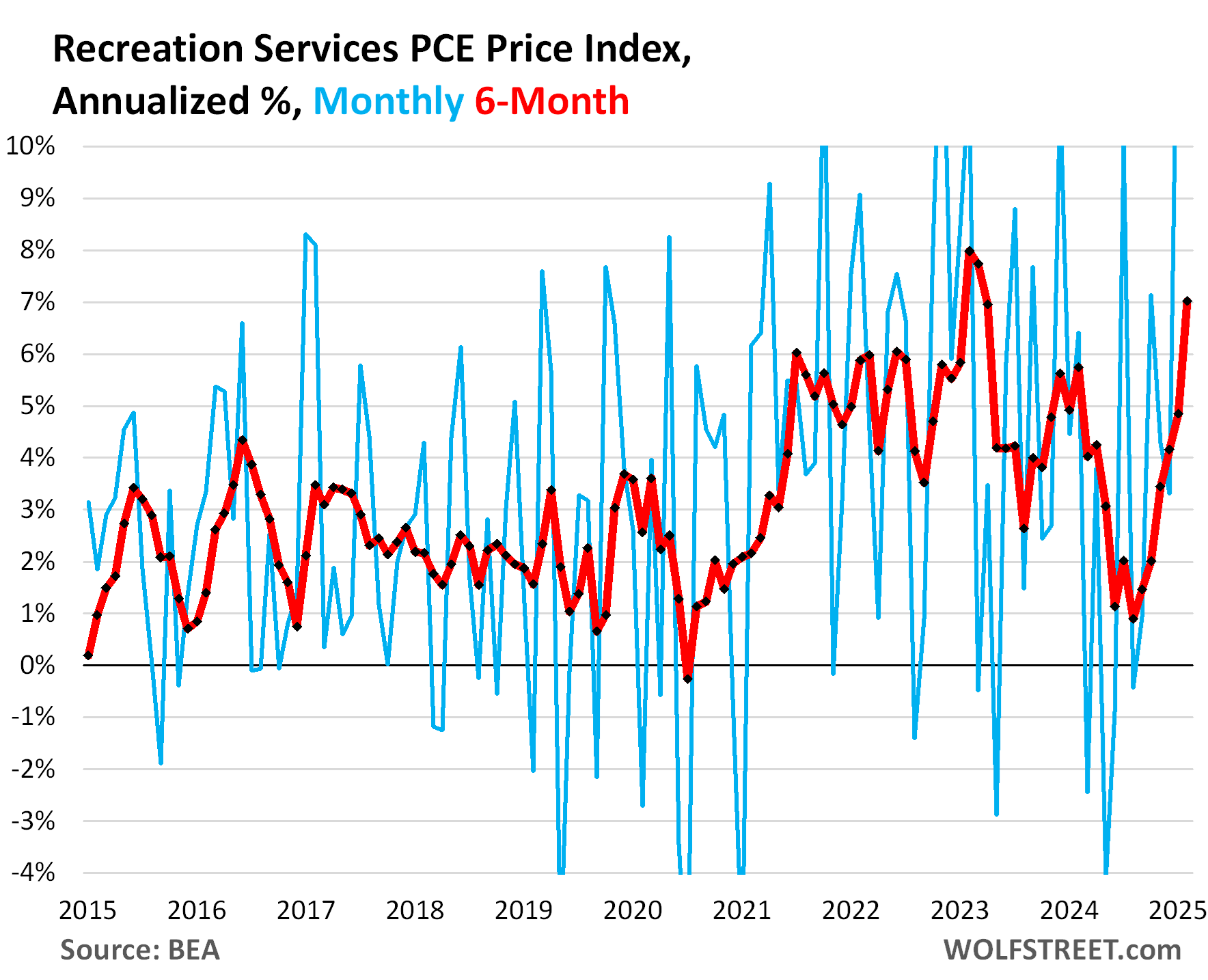
Of the remaining services categories, only transportation services, which includes airline tickets, booked a month-to-month decline in February:
- Transportation services (-2.5% annualized)
All other services booked hefty month-to-month increases:
- Healthcare services (+4.1% annualized)
- Insurance (+3.9% annualized)
- Food services index (+4.4% annualized)
- Non-energy utilities (+12.8% annualized)
- Financial Services (+6.1% annualized)
- Other services (+7.7% annualized).
On a year-over-year basis:
- Overall PCE price index (red): +2.5%, same as in January. The Fed’s target is 2.0%.
- Core PCE price index (blue): +2.8%, up from January (+2.7%)
- Core Services PCE price index (gold): +3.6%, up from January (+3.4%)
- Durable goods price index (green): -0.9%, less negative than in January (-1.2%)
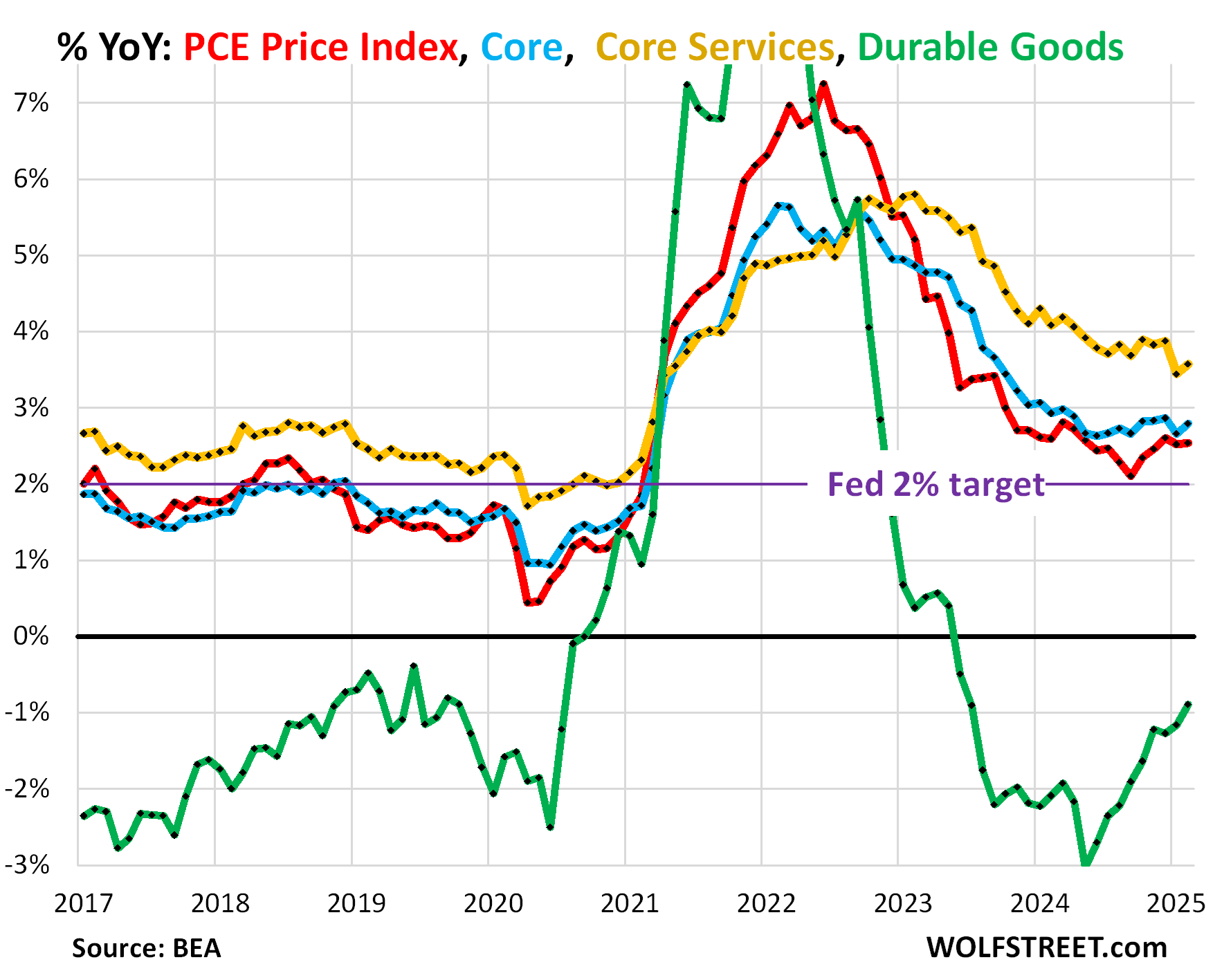
Enjoy reading WOLF STREET and want to support it? You can donate. I appreciate it immensely. Click on the mug to find out how:
![]()


The Fed’s inevitable hawkish response: Even more rate cuts.
Rate cuts, the Fed’s fentanyl.
They may have to raise rates. Tbh
The economy would nosedive if they did raise them.
our debt ridden consumers continue to pile on
heck, I’m taking on some debt when we close on vacay property
I’m only putting down 62% and amortizing over 5 years at 4%
A good recession or depression wipes out inflation. Look at 2008. It went from 5.6% inflation to deflation in 6 months.
That was the price of energy that did that. It had spiked, with oil going to $150 a barrel and then collapsing.
You can see that because core inflation, which excludes energy (and food), maxed out in 2006 at 2.9% and then gradually meandered lower. In 2008, it ranged from 2.3% to 2.5%. The spike in overall CPI in 2008 and then the cooling of it was entirely due to energy.
More bad news for the country and the market. I am a natural pessimist but anything less than 3% inflation is not too terrible.
With permission of the boss (Mrs. Terrahawk), I went to 40% cash by the beginning of January. I was a bit early, but I always am.
I don’t ever seem to have problems finding the tops, it is the reentry points that confound me. 20% down always looks enticing. I just don’t have the same confidence.
You should do what I do. I went to 20% cash in January and am slowly nibbling back in. Here are my “tranches:”
1. 10% S&P 500 drop from ATH: 25% purchase (already happened)
2. 20% drop: 45% purchase
3. 30% drop: 30% purchase
I have 180 day limit orders set up in my brokerages. They will trigger once the S&P hits these pre-determined setpoints.
How much will you buy at 50% drop from ATH?
mortgage the house perhaps
Any money he has left will go towards new briefs.
As much as I can stuff into my 401(k), Roth IRA, and after tax brokerage. A 50% drop would bring things back to reasonable levels and set up the next twenty years of my working career with nice returns.
3% inflation HALVES the value of your money in about 20 years.
Considering that that is just their measurement which pretty much everyone agrees understates real inflation, it’s quite a bit worse than that.
About 24 years per the rule of 72. Inflation of 3.6% over 20 years would about cut the value of your money in half.
Even inflation of “only” 2% over 20 years cuts the purchasing power (the “real value”) of your money by almost one-third. Inflation truly is the silent tax.
it’s called DEVALUATION of fiat $dollar
inflation is ‘pull blanket over sheeple eyes’ word
You should do what Warren does – don’t buy based on how much it has dropped, but based on valuations. This way you are trying to time anything, you are simply reacting to “price”.
yeppir as long as we cash flow, putting cash piles into real assets is only way to go
and no STOCKS are NOT assets
remember Warrens advice – own CONTROLLING interest(ie 51% min.)
How are stocks not assets?
At least stocks are deflating and rather substantially…
Dow 41,579.33 -720.37 -1.70%
S&P 500 5,581.86 -111.45 -1.96%
Nasdaq 17,341.58 -462.46 -2.60%
Just checking in in regards to your previous comments about the price of gold
IIRC we are now up around $600 an ounce since you bashed the price of gold last and over $1000 an ounce over the past year.
Care to make more forecasts or or comments on how gold was overpriced at those previous levels?
$20 per pound would be a very generous price for this yellow metallic substance of no financial relevance whatsoever. It’s only real primary use – jewelry – is now falling significantly due to its inflated price and the only thing holding up the price is manic rabid speculation.
You obviously don’t have any idea of what you’re talking about!
Physical Gold is on a slow & steady increase (Traded @ $3,100/toz
0n 2/28) & there are multiple reasons why.
James,
He’s being hilarious.
Fortunately for the gold holders in the US, the current “manic rabid speculation” is mostly by foreign central banks, who seeing the seizure of Russian financial assets by the US, have decided to convert a lot of their green paper to as much of your $20/lb. yellow stuff as they can get. The US financial markets and the public are still very drowsy to the move in gold.
Gold is incredibly valuable for electronics due to its excellent electrical and heat conductivity.
That is it’s true “intrinsic value”. But still not $3000/oz valuable.
Better place your bet now and buy in this rare buy the dip opportunity, cause you know if you don’t get in now, Dow will be back up to all time high next month. Just look at Bitcoin, even after all the hoopla, we are still at $84k and Cathie Wood told us Bitcoin will be $1m soon..
There is always a bigger fool.
Until there isn’t.
Good luck.
Fed needs to cut rates now according to our Dear Leader..must be some 4D chess mental gymnastics strategy for cutting rates to bring down inflation or they are just copying Turkey’s playbook…sure it’s going well over there..
If Dear Leader doesn’t get what he wants…despite what PowPow said before and got asked again recently, we will see ultimately if it will hold any weight..
Does he really want the rate cuts or does he just want a whipping boy?
Trump likes “heads I win, tails you lose” situations.
Many of his biggest fans don’t realize the difference between short and long-term rate cuts, they will think he’s fighting for them and trying to reduce inflation if he pounds the table for cuts.
Perception over reality…
Guess what happens when the US government goes on a spending spree at the end of its term in office by dumping as much as it can before leaving office.
Those huge budget deficits have consequences and the timing is just about right for all of those funds to be finally working their way through the economy.
no need to blame someone else for the FED’s own persistent failure.
When is the last time the FED was correct in it’s actions over a multi-year period? Maybe the early 2000’s or late 90’s?
“correct” is in the eye of the beholder. People with residential RE and stocks have long praised the Fed for doing the right thing (ZIRP and QE), to inflate all markets. Now they’re blaming the Fed for screwing it up.
Amen.. house humpers and big whales think the FED is doing a great job and probably deserve a gold star when they drove mortgage rates through 10yrs yield to the lowest in history…in fact some are still foaming at the mouth thinking it will return someday like Jesus..
The rest of the normies barely even know what the FED does or know who Greenspan was…to those that know that do not have vested interest from cheap money I can safely assume absolutely loathe them in helping to create worsening inequality and seems completely tepid in response to monetary policies that continues to a rip a new one for non assets holders.
Well, they attempted a soft landing, but looks like they undershot the runway… or something.
andy
Mar 17, 2025 at 6:38 pm
Sell your second car, buy triple-short ETF. Thank me later.
Now you have to wait for next bear market rally. Sell that car in the meantime.
Are you talking about buying TQQQ?
TQQQ is triple-long etf. You buy it for a bounce (bear market rally). I bought calls in TNA (3x-bull small caps) near close today (for a bounce). I think small caps will fare better than Nasdaq. Big picture – bear market is just starting I think.
Probably.
No way to really tell.
There’s a part of me that suspects this is “intentional”. Drop the over-extended market with silly whiplash policy. I know that seems silly, yet….
Buy Low.
Push a new Tax policy and get it approved lightning fast, RIDE wave back up.
Good luck with that, unless you have specific advance info down to a day on the market will drop big in one day, that triple-short ETF will take you to the cleaner in no time even in a bear market…ask me how I know..
Thank you. So far it is following 2022 (down to a t almost). Dec 31, 2021 = Feb 19, 2025.
Just buy some gold. Governments, no matter how they try, always inflate. Gold has stood the test of time.
If only I had opened a nice position in SQQQ when I went 70% cash in February.
I played the SQQQ game before and did ok, I just don’t like the built in decay or how closely I had to watch it.
I have slept like a baby since I went cash. There just too many factors pointing to imminent drop, clearly we were all correct.
Same as Terrahawk here, hard to tell when to re-enter. Trying to watch technicals for a good re-entry. Seems like this bird is going down further though, VTI tagged the 200 MA and went rt back down.
SP500 —->> 4500? Lower?
I look at 2022 for guideline. It tracks so far. Same double-top (end of 2021). If this continues to track, then sp500 should reach around 5200-ish before next big rally (back to 5700-ish). Then 4200 by end of summer/early fall.
Probably best to aim at bigger target (4K on S&P by year end), so as not to be shaken out.
Like 2022 bottom. Lower monthly bollinger band was the low Months to go yet. Only question. How fast does the spy qqq take to get there
The woman I’m seeing thinks its sexy I invest in bitcoin
Hey man whatever it takes lol
Just show her some 1″s and 0″s on your computer screen, tell her it’s Bitcoin and you are in!
Proceeds to tape post it notes with “1’s” and “0’s” to computer screen.
😆
Ah crypto queen technology! Fake curves and now AI photos and conversations.
haha are you really seeing her or is it another one of those pig butchering relationship type of relationship? Did she text you at a random with some cute pictures of herself and then convince you bitcoin is a sure win investmet?
Conjugal visits with Caroline. Living the dream.
Tell the woman you’re seeing that you’re going to mint your own meme coin with the same name you use here… 😁. Then she’ll think you’re Mr. Universe.
Broadband is a recreational service? It’s well past time to change that. Try living without internet today. It’s like living without electricity. Yeah, it’s possible, but practically no one is going to live without it.
Some people think that video streaming is on the same level of can’t-live-without-it essentialness as food and shelter.
Audio streaming is my new thing–finally. Apple Music with Apple Music Classical is $10.99 a month. Apple’s new iPad (A 16) Wi-Fi 128GB is $350 and works great. You can use a voice activated option on the iPad to select what you want to hear. Really amazing technology for three-fifty.
High-end streamers for audio can range into the thousands of dollars. For example, a Luxman DA-07X ‘Network Audio Player’ is $7,495. With the iPad you can get high-res lossless music that sounds great. One thing you do need is a good quality DAC, which the Luxman has, to go with the iPad. My DACs are made in Texas by Schiit Audio.
Only complaint is that the artists who’s music is streamed really don’t get compensated enough per each stream–and that’s pretty much across the board with all audio streaming services. But it’s nice to listen to an album you’re thinking about buying first. And it’s cool to hear some of the remastered classics that I have on vinyl in the high-res format. So many choices for so little money!
Thanks for the explainer. I couldn’t tell what was on the iPad. Too pixilated.
A $10 Apple dongle (USB to 3.5mm adapter with built in DAC) and a $25 pair of decent IEM’s are good enough for most people (including me).
But happy to see at least someone is spending freely to keep this economy moving along.
Don’t watch a lot of video, and what I do watch is mostly educational at that, but I’m definitely dependent on music streaming. However I still own all the CDs I collected since the 1990s, just in case. I love having physical media — it’s useful for a lot of things, not just music (e.g. remember when you could own software and not just rent it?).
Cole – corporate opposition to changing the ‘recreational’ classification for broadband (instead of ‘telephone communications’, a public-utility classification) is a significant aspect of the abysmal state of affairs in dealing with the U.S.’ urban-rural “digital divide” (imagine the nation, and our history, without the effects of the now-departed New Deal program of the REA-even Woody Guthrie said: “…I don’t like dictators, but I think the whole country should be run by electricity…).
may we all find a better day.
I hope the Fed will finally admit it’s mistake. Nice article.
does this look like a forthcoming apology?
(Reuters) – San Francisco Federal Reserve Bank President Mary Daly still sees two interest-rate cuts this year as a “reasonable” projection, but with the labor market solid, the economy still growing and inflation edging down, policymakers can wait to reduce rates until they assess how businesses will adjust to tariff costs.
They started cutting rates with prices of stocks, housing, and almost everything else at All Time Highs. Doubt this was a mistake.
Mistakes are transitory
And have no personal employment accountability.
If the FED holds reserves constant, then money flows should follow this path:
8/1/2024 ,,,,, 0.008 bottom
9/1/2024 ,,,,, 0.027
10/1/2024 ,,,,, 0.04
11/1/2024 ,,,,, 0.054
12/1/2024 ,,,,, 0.069
1/1/2025 ,,,,, 0.086
2/1/2025 ,,,,, 0.082
3/1/2025 ,,,,, 0.072
4/1/2025 ,,,,, 0.092
5/1/2025 ,,,,, 0.096
6/1/2025 ,,,,, 0.103
7/1/2025 ,,,,, 0.101
8/1/2025 ,,,,, 0.11
9/1/2025 ,,,,, 0.113 top
10/1/2025 ,,,,, 0.107
11/1/2025 ,,,,, 0.108
12/1/2025 ,,,,, 0.085
1/1/2025 ,,,,, 0.097
Good thing the Fed cut QT to practically ZERO.
It cut it in half, not zero, but to around $20 billion a month.
The Fed needs to step up their QT. They need get all that crap off their balance sheet before the next recession hits. It’s probably already too late. That’s what Paul Volcker would do. He’s rolling in his grave as we speak.
When they can not sell government debt to the public, guess who will come riding to the rescue, the Fed!
Powell: “As is often the case, we are navigating by the stars under cloudy skies.”
“For example, u* (pronounced “u star”) is the natural rate of unemployment, r* (“r star”) is the neutral real rate of interest, and Π* (“pi star”) is the inflation objective. According to the conventional thinking, policymakers should navigate by these stars.3 In that sense, they are very much akin to celestial stars.”
Not even as good as the weather man.
Question on inflation and the durable goods portion.
I am pro Trump policies and trust the process for the long term much like the Fed and QT though we know everyone makes mistakes (QE)
Ben S. Bernanke – Chairman and a member of the Board of Governors of the Federal Reserve System. Chairman of the Federal Open Market Committee, the System’s principal monetary policymaking body.
“At the same time, because economic forecasting is far from a precise science, we have no choice but to regard all our forecasts as provisional and subject to revision as the facts demand. Thus, policy must be flexible and ready to adjust to changes in economic projections.”
Janet L. Yellen, President and CEO of the Federal Reserve Bank of San Francisco
“You will note that I am casting my statements about the stance of policy and the outlook in very conditional terms. I do this because of the great uncertainty that surrounds these issues. Frankly, all approaches to assessing the stance of policy are inherently imprecise. Just as imprecise is our understanding of how long the lags will be between our policy actions and their impacts on the economy and inflation. This uncertainty argues, then, for policy to be responsive to the data as it emerges, especially as we get within range of the especially as we get within range of the desired policy setting.”
Robert W. Fischer – President Dallas Federal Reserve Bank
November 2, 2006:
“In retrospect [because of faulty data] the real funds rate turned out to be lower than what was deemed appropriate at the time and was held lower longer than it should have been. In this case, poor data led to policy action that amplified speculative activity in housing and other markets. The point is that we need to continue to develop and work with better data.”
The data wasn’t faulty. They just dismissed the data that they didn’t like. And they did it again in 2021, which is where the “transitory” came from. They dismissed data they didn’t like as “transitory.”
Rust, GIGO, and the Peter Principle, never sleep…
may we all find a better day.
I, and every reader here, knew that inflation was re-heating up about 6 months ago – thanks to Wolf.
Wish some of the FED board would read Wolf every now and then. Although in fairness, they do need to please their masters and likely knew and ignored the facts anyway.
“Fed Started Rate Cuts at the Low Point 6 Months Ago…” Looks like the Federal Reserve got that “disinflation” turned around in the nick of time.
Well, once we take Greenland then we can exploit it for all the natural resources it has now that ice is melting. That should turn things around, including significant declines in tourism. Wonder what that is all about.
The people of Greenland should be preparing to fight a protracted guerrilla war against their would-be invaders.
How does anyone take the fed seriously at this point? Blows my mind.
Almost to the finish line of achieving…. Stagflation
I am sitting here contemplating the end of the dollar hegemony. The end of the United States trading and tribute empire. It is all tied up together, and the budget deficit is the engine of the world economy. The sheer amount of goods imported to the United States at the world price has allowed an immense prosperity. Now we are deliberately ending this. It will require more change than anybody seems to expect.
The huge imbalance between wages and asset prices will have to change. This will have to happen. Now, the only question is how?
We have so much to fix, and we could have chosen a rational process to achieve the next island of stability. Now we have the storm instead, and political paralysis.
Our credit systems are still working at the moment. This too will change. The crushing federal debt will force change when rates get to 10%.
The real question should be gold at $50k, and silver at $1k, and high unemployment (think 12-15 percent), in three years. And house prices down 30 percent.
Now that would be unthinkable, wouldn’t it?
Back to the old tagline.
Someday this war’s gonna end…
CA:
“I am sitting here contemplating the end of the dollar hegemony”
Not likely but in any case, sit back and have another stiff cocktail…
“the end of the dollar hegemony” to be replaced by what? BRICS, a bunch of third world countries pretending they know what they are doing? EURO, a bunch of socialist countries most of which will be caliphates in ten years or so? The RENMINBI, a collapsing economy whose decline will accelerate when the US on-shores its manufacturing and decline even faster after China invades Taiwan? Sorry, the dollar is the only game in town.
“The end of British sterling hegemony”? Replaced by what? The Latin Monetary Union, a collection of debt-ridden European nations struggling to maintain a gold standard? The Austro-Hungarian krone, from an empire teetering on the brink of collapse? The German mark, issued by a country whose economy will implode under the strain of war reparations? Sorry, the pound is the only game in town.
USD for a local daily useable money in transactions but Gold is the only game in town not Federal Reserve Notes for real money.
Dmoney, you conveniently (for you) left out the US dollar, which in fact replaced the British pound.
I think you are massively overstating the concerns. If there is anything my 60-year old self would like to make clear to my 30-year old self… it is to not take the naysayers of the American economy too seriously. For too long I have listened to people make seemingly rational arguments about why the stock market won’t go up, the dollar won’t stay strong, and that the economy is on the verge of a(nother) precipice. With very few exceptions over the past 30 years those seemingly strong arguments have just been flat out wrong.
I mean seriously… can you actually imagine an American economy in which gold is up 8-fold but house prices are down 30%? Both gold and property are hedges against inflation… so how does that make any sense at all? And in what fantasy world does all of that happen (PLUS 12 to 15% unemployment) in just three short years???
Stop being a Nervous Nellie!
The ten year Treasury note dropped a sizable .116 to 4.253 today, in the face of a higher than expected core PCE, and apparently increasing inflation. I am guessing the bond market is betting on a souring economy, which might take care of inflation. There is always stagflation to think about.
The Fed might have to decide whether it wants a light recession or higher inflation. Powell might eventually play the “transitory increase in inflation” card again, blaming the increase in inflation on a one-off increase because of tariffs. That might play for some for up to a year. But recall that core inflation has been creeping up for six months before any tariffs have kicked in. The only thing we know for sure is the Fed will make the wrong decision.
I only really care about the 3 month T-bill rate, and I hope it goes higher for longer.
Why is anyone surprised by this? It was obvious at the time that the fall rate cuts were a mistake, as was the failure to keep raising rates over the previous year. Not sure if the Fed was playing politics or just incompetent. Maybe a little bit of column A and a little bit of column B.
Isn’t it obvious. They are deathly afraid of triggering a negative feedback cycle. Inflation must be some number above 2% at all times!
As predicted housing costs are going to drop below inflation for the near/medium term.
You are missing the point! All we need is a trading platform fast enough to connect all the trades. AI will solve that very soon and everyone will be able to trade what they want, for what they have. Sadly it will not be based in the US due to our bias for the dollar.
A slow death by a thousand cuts. Imagine a world where you due not have to use one fiat currancy. It is already happening at a slow pace and will accelerate.
Oil for gold, wheat, medical supplies, or anything else you might want. Millions of trades processed in seconds without any BS rules or teriffs. Made in the US, good luck with that unless you want to be another North Korea.
It’s called “bartering,” a system of exchange that was so cumbersome and inconvenient that it was replaced by currency millennia ago. Currency was invented to solve the kinds of problems bartering imposed on the parties. Now you want to go back to bartering because you dressed it in new clothes? LOL
Bitcoin is meant to become “electronic barter” a transactional currency which matches up the buyer and the seller and then disappears. It’s definitely not the speculative security it is right now. When the computers match up the barter trades and there is something left over that goes into the most solid commodity which is likely gold. Everything is a real asset except of course fiat currency. The process of commodifying raw materials sets the precedent but if products vary in quality, the computer can adjust the ratio. There are five grades of US corn. Imagine how to figure a tariff, when the article has a large number of tariffed components and each country that provided the component is tariffed differently? There will be no tariffs, and the system is straightforward enough, except for trade imbalances. If the US ran a trade deficit with China for 50 years in this system there would be no gold in Fort Knox and China would have all the rights to our technology. Larger producer nations would become wealthier, but that should be self-limiting, according to the laws of supply and demand. The variable in bartering two identical items half a world apart is transportation. Barter is the only fair and workable global economic system.
Barter is nothing other than anachronistic inefficient nonsense.
What is a wheat farmer supposed to do with barrels of unrefined oil? Or a bandage factory? Or a gold miner?
If a librarian wants to fill his car with gas, does he only get to do that when the gas station owner wants some help researching the Hellenic war?
Feels like you haven’t actually thought through the impracticality of this modern barter system.
Since 1965, this country has experienced, in tandem, two types of inflation. One characterized by a relentless rise in consumer and producer prices. Inflation, at varying rates, has persisted irrespective of the cycles of the business economy. This phenomenon enabled economists to coin a new term stagflation; business stagnation accompanied by inflation.
The other inflation has been largely confined to rampant speculation in urban and rural real estate. This inflation has been so excessive it has produced the “boom and bust” characteristic of all past speculative orgies.
Inflation cannot destroy real property nor the equities in these properties. But it can and does capriciously transfer the ownership of vast amounts of these equities thus unnecessarily accelerating the process by which wealth is concentrated among a smaller and smaller proportion of people. The concentration of wealth ownership among the few is inimical both to the capitalistic system and to democratic forms of government.
“The smartest guys in the room”
The Fed needs to hire some more Ivy League economists.
/s
The FED should cut short-term interest rates as soon as possible. But at the same time, they should have continued with, even increased, existing QT.
Interest is the price of credit. The price of money is the reciprocal of the price level.
The effect is to drive the banks out of the savings business, which doesn’t reduce the size of the payment’s system. The effect is to activate bank-held deposits.
The commercial banks are credit creators. The non-banks are credit transmitters. Lending/investing by the DFIs expands both the volume and the velocity of new money. Lending by the NBFIs increases the turnover of existing deposits (a transfer of ownership), within the commercial banking system.
The FED’s correct response to stagflation is the 1966 Interest Rate Adjustment Act.
Waller, Williams, and Logan seem to agree. They “believe the Fed can keep unloading bonds even when officials cut interest rates at some future date.”
That’s called targeting N-gDp as Scott Sumner advises.
We’re likely to see rates closer to healthy numbers, as they currently are, for longer. Durables will likely uptick with the tariffs, and everything else is somewhat unknown, but a slight decline in inflation wouldn’t be unexpected. The trailing averages in the charts are nice on the eyes, but only tell a historical story, they are overlayed with more current data so it provides the illusion of recency, but are out of date, and should be shifted left to their center of record.
It’s our summer of 1978 folks/ Go back and look at the charts. The second wave of inflation is just starting. Hedge accordingly.